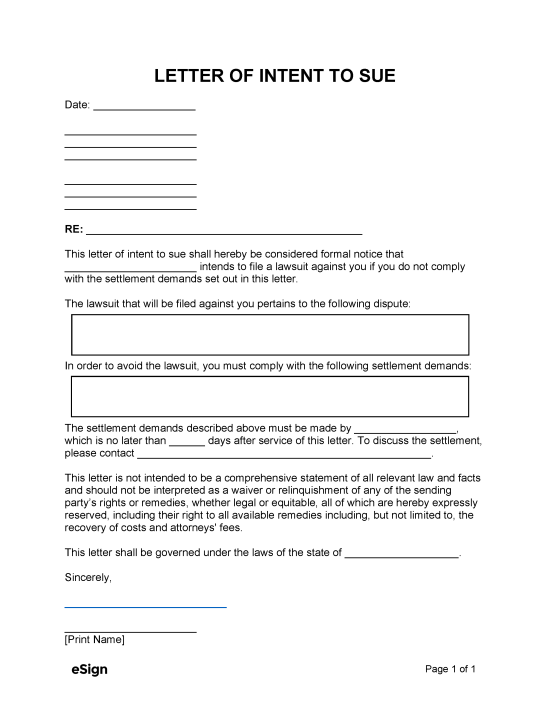Sample
Download: PDF, Word (.docx), OpenDocument
LETTER OF INTENT TO SUE
Date: [MM/DD/YYYY]
[SENDER NAME]
[SENDER STREET ADDRESS]
[SENDER CITY, STATE, ZIP]
[RECIPIENT NAME]
[RECIPIENT STREET ADDRESS]
[RECIPIENT CITY, STATE, ZIP]
RE: [SUBJECT MATTER]
This letter of intent to sue shall hereby be considered formal notice that [PLAINTIFF NAME] intends to file a lawsuit against you if you do not comply with the settlement demands set out in this letter.
The lawsuit that will be filed against you pertains to the following dispute: [DESCRIBE INCIDENT].
In order to avoid the lawsuit, you must comply with the following settlement demands: [EXPLAIN HOW TO SETTLE DISPUTE].
The settlement demands described above must be made by [MM/DD/YYYY], which is not later than [#] days after service of this letter. To discuss the settlement, please contact [CONTACT INFORMATION].
This letter is not intended to be a comprehensive statement of all relevant law and facts and should not be interpreted as a waiver or relinquishment of any of my rights or remedies, whether legal or equitable, all of which are hereby expressly reserved, including my right to all available remedies including, but not limited to, the recovery of costs and attorneys’ fees.
This letter shall be governed under the laws of the state of [STATE NAME].
Sincerely,
___________________
[SENDER PRINTED NAME]
How to Write
- Header – The date the document was drafted and the parties’ names and addresses.
- Subject – A brief description of the document’s contents.
- Opening Paragraph – A summary of the letter’s intent and the reason for sending.
- Dispute -The details of the incident between the parties.
- Settlement Demand – The sender’s proposed remedy for the situation.
- Deadline – The deadline to comply with the LOI.
- Governing Law – The state whose laws will govern the dispute.
- Sign-Off – A letter of intent to sue typically closes with a formal valediction (e.g., sincerely, regards, etc.) and the plaintiff’s signature.
When to Use an LOI to Sue
Sending a letter of intent before filing a lawsuit can avoid the need for resolving the dispute through the court system if the recipient complies with the letter’s demand. This type of doucment is often used in the following situations:
- Outstanding client payments
- Poor or incomplete work by contractor
- Breach of contract
- Property damage
- Landlord refused to return security deposit
- Driver refused to pay for repairs in car accident
- Denied insurance claim
Legal Requirement
In some cases, plaintiffs may be legally required to send a letter of intent to sue before a lawsuit can be filed. Failing to do so may result in their claims being dismissed by the court. It is recommended to consult a lawyer to verify the applicable laws. Below are examples of when a letter of intent to sue may be required:
- Claims involving consumer protection statutes.
- Complaints against insurance companies.
- Medical malpractice suits.
- Lawsuits against governmental bodies.
- The requirement was included in a legal agreement between the parties.
- Breach of warranty claim.
Tips for Drafting an LOI
- Legal Counsel. It is recommended to consult an attorney before drafting the letter.
- Delivery. Sending the letter via certified mail provides proof that the defendant received it.
- Language. A letter of intent to sue should have professional and polite language.
- Length. The letter needs to clearly describe the demand while keeping an appropriate length (typically one page).

